Introduction
Amid short-term uncertainty, the government’s Plan to Build is creating conditions for long-term economic growth and a strong future for Ontario. The government has taken significant actions to drive growth by lowering costs, getting key infrastructure projects built faster, attracting more jobs and investment, and cutting red tape to help businesses, families and workers. This plan is building a strong Ontario economy for the future, today.
Building Ontario’s Economy for Today and Tomorrow
Ontario, like the rest of the world, continues to face uncertain times, as a result of heightened geopolitical instability and ongoing supply chain disruptions that are putting a strain on the economy and have resulted in higher inflation and interest rates. The United States’ Inflation Reduction Act is also threatening Ontario jobs and competitiveness.
The government’s Plan to Build is the right plan to navigate Ontario through the difficult challenges of today and build a strong economy for the future.
The province has attracted historic new investments in the automotive sector and clean steel to strengthen Ontario’s manufacturing sector. The government has undertaken significant actions to improve competitiveness by lowering costs for business. In 2023, the government would enable an estimated $8.0 billion in cost savings and support for some Ontario employers, with $3.6 billion to go to small businesses. This includes savings from the new Ontario Made Manufacturing Investment Tax Credit proposed in this Budget.
Since 2018, the government has also reduced unnecessary red tape, saving people, businesses, municipalities, not-for-profit organizations, universities and colleges, school boards and hospitals $576 million in annual regulatory compliance costs.
Ontario’s current population has exceeded the 15 million milestone with net migration to the province reaching over 275,000 people in 2021–22, the highest ever recorded. By 2042, it is projected that nearly 20 million people will call Ontario home. This is an enormous opportunity but also an enormous effort to ensure the province is prepared to welcome the many newcomers that are driving Ontario’s population growth. The province will need more infrastructure and housing. Ontario will need to produce more, continue to attract investments in key industries and create more, good-paying jobs.
The government will continue to take a responsible, targeted approach as it delivers on Ontario’s Plan to Build to help people and businesses while laying a strong fiscal foundation for future generations.
Unlocking Northern Ontario’s Economic Potential
Building the Corridor to Prosperity
Critical minerals are key to the economy of the future. These important resources are critical to products that the people of Ontario rely on, including cell phones, electric vehicles (EVs), and the semiconductors in countless goods. Critical minerals are some of the most sought after commodities in the global economy and Ontario happens to be one of the rare places on earth with many of these natural resources available. Ontario’s endowment in critical minerals can be leveraged to encourage domestic mining and processing that support the high-value downstream activities in the electric vehicle supply chain such as automotive and battery manufacturing. This is a competitive advantage that cannot be ignored.
Ontario is helping to build a strong critical minerals sector in the province. Through investments and support, the government is unlocking Northern Ontario’s economic potential in critical minerals and connecting these resources to the world-class manufacturing capabilities in Southern Ontario. Ontario has tremendous opportunities for critical minerals to support future economic prosperity.
The Ring of Fire is one of the most promising mineral deposits in Canada. It has the potential to play an important role in supporting innovative technologies for high-growth sectors such as batteries, electronics, electric vehicles and cleantech and to bring multigenerational opportunities to Northern and First Nation communities. By working with First Nation partners, Ontario has a tremendous opportunity for a corridor to prosperity that can leverage health, economic and social benefits, while unlocking significant economic growth.
All-season, dependable road access is a prerequisite to unlocking opportunities in the region and creating better supply chain connections between Ontario industries, resources, workers and communities in Northern Ontario and manufacturing in Southern Ontario. This is why Ontario is making investments to continue working with First Nations and industry on key Ring of Fire projects. These investments are part of Ontario’s commitment of close to $1 billion to support critical legacy infrastructure such as all‑season roads, broadband connectivity and community supports for the Ring of Fire region. All‐season road access will also help bring prosperity to First Nation communities, improving access to education, health care, goods and services, and housing.
The government also continues to support the Environmental Assessments for the Marten Falls Community Access Road project, the Webequie Supply Road project and the Northern Road Link project, led by the Marten Falls First Nation and Webequie First Nation. The Terms of Reference for the provincial Environmental Assessments for the Marten Falls Community Access Road and the Webequie Supply Road were approved in 2021. The Terms of Reference for the Northern Road Link was approved in March 2023.
Ontario will continue to call on the Government of Canada to step up and match Ontario’s funding commitments to getting the roads to the Ring of Fire built.
Advancing Ontario’s Critical Minerals Strategy
The government is investing in exploration and innovation to support critical minerals including those in the Ring of Fire, and to help make Ontario a leading producer of critical minerals. Ontario has numerous competitive advantages, in addition to its vast mineral wealth, including a clean grid that allows for development of cleaner, lower-emissions mining compared to other jurisdictions. The province is also a leading mining finance jurisdiction, with about 40 per cent of the world’s public mining companies listed on the TSX and TSXV.
Ontario’s Critical Minerals Strategy will help secure the province’s position as a reliable global supplier and processor of responsibly sourced critical minerals. The Critical Minerals Strategy is a five-year roadmap that focuses on six pillars that will support better supply chain connections between industries, resources and workers in Northern Ontario and manufacturing in Southern Ontario, including Ontario‐based EV and battery manufacturing. The six pillars of the strategy are:
- Enhancing geoscience information and supporting critical minerals exploration;
- Growing domestic processing and creating resilient local supply chains;
- Improving Ontario’s regulatory framework;
- Investing in critical minerals innovation, research and development;
- Building economic development opportunities with Indigenous partners; and
- Growing the labour supply and developing a skilled labour force.
Supporting Mineral Exploration in Ontario
The government is continuing to invest in its Critical Minerals Strategy through the Ontario Junior Exploration Program, which began in 2021. The Ontario Junior Exploration Program helps junior mining companies finance early exploration projects by covering up to $200,000 in eligible costs for critical and precious mineral exploration and development. The government is investing an additional $3 million in 2023–24 and $3 million in 2024–25 into this successful program, which will help more companies search for potential mineral deposits and attract further investment in this growing sector. With this new funding, the government is investing a total of $13 million in 2023–24 and $13 million in 2024–25 in the Ontario Junior Exploration Program. This includes $4 million per year for a Critical Minerals Stream.
The government also supports the mining industry through the tax system. This includes Personal Income Tax relief for investment in flow-through shares, as well as the Ontario Focused Flow-Through Share Tax Credit for investment in mineral exploration activity in Ontario.
With the recent introduction of the federal Critical Mineral Exploration Tax Credit, Ontario expects to provide an estimated $25 million per year in additional relief to support investment for a competitive mining sector with good jobs.
Assisting Mining Projects Through Improvements to the Mining Act
To help seize the economic potential of the province’s minerals, and to support the geopolitical need for secure access to resources, Ontario introduced legislation in March 2023 to amend the Mining Act. If passed, the Building More Mines Act, 2023 would ensure Ontario has a modern and competitive regime for mineral exploration and development. The proposed amendments aim to save companies time and money by reducing administrative burden, clarifying requirements for rehabilitation and creating regulatory efficiencies. These changes will help Ontario attract mining investments to support the unlocking of critical minerals and the Ring of Fire, while maintaining Ontario’s strong standards for environmental protection and meeting the Duty to Consult with Indigenous communities.

Attracting Clean Steel Investments
As companies, including those in the automotive sector, find ways to reduce emissions in their supply chains, the production of green steel will help Ontario remain competitive as the world transitions to a greener economy. Between 2005 and 2020, Ontario recorded the largest decline in greenhouse gas emissions among all provinces and territories.
The government is helping to make Ontario a supplier to manufacturers of the future and the place for investments in clean steel. This will enhance the province’s competitive advantage in attracting game-changing investments, as well as creating and retaining skilled, local jobs for Ontario workers. Ontario’s domestic steel industry and its customers, including major automotive, mining, energy and construction companies, are working together to reduce the environmental impact of their operations and products, helping Ontario achieve its target of reducing greenhouse gas emissions by 30 per cent by 2030.
Ontario has attracted $2.5 billion in recent investments that will support transformation in the steel sector and help cut greenhouse gases by up to six million tons or the equivalent of taking nearly two million cars off the road. This includes ArcelorMittal Dofasco’s $1.8 billion investment in Hamilton, announced in February 2022, to replace its coal‐fed coke ovens and blast furnaces with new, low‐emission technology, which is targeted for completion by 2028.
Additionally, in November 2021, Algoma Steel in Sault Ste. Marie announced a $700 million investment in a new, low‐emission electric arc furnace. The project will feature a pair of electric arc furnaces that will replace the plant’s existing blast furnace, coke oven batteries, and basic oxygen steelmaking operations. Algoma recently announced the installation of the first structural steel columns at its electric arc furnace steelmaking facility, a significant project milestone. The furnaces are expected to come online in 2024, and ultimately, the transformation aims to reduce Algoma’s greenhouse gas emissions by up to 70 per cent when construction efforts reach the final stages in 2029.

Bringing Manufacturing Jobs Back to Ontario
Ontario’s Plan to Build is attracting key investments and creating meaningful opportunities for people, families and businesses across the province. In 2022, Ontario secured more than 150 new investment deals from a wide range of sectors including automotive, technology, manufacturing and life sciences. These investments will help to create and retain thousands of good-paying jobs within communities across the province. Ontario’s Plan to Build will also improve the province’s competitive advantage as a place to do business while at the same time encouraging existing businesses in Ontario to expand their operations.
While Ontario continues to attract investments, create jobs, hire more people and drive economic growth, it is facing a significant competitiveness challenge from the United States’ Inflation Reduction Act (IRA), which provides enormous subsidies from the U.S. federal government to favour U.S. operations. As Ontario does its part to ensure the province remains competitive, it is looking to the Government of Canada to provide a robust national response that addresses the negative impacts of the U.S. legislation.
In addition, as announced in the 2022 Budget, Ontario will establish an Advanced Manufacturing Strategy to help boost the long-term competitiveness and resilience of the sector. As a next step, the government is creating the Advanced Manufacturing Council to help inform the strategy and provide input into its development.
Launching the New Ontario Made Manufacturing Investment Tax Credit
Ontario’s manufacturing sector is a key contributor to the economic success of the province. However, by 2018 employment in Ontario’s manufacturing sector declined by over 300,000 workers from 2004. Over this period, the competitiveness of the sector was negatively impacted by the high cost of doing business, gaps in skills training programs, and a lack of business investment.
Since 2018, the government has helped attract billions of dollars’ worth of investments in automobile and clean steel manufacturing, creating new opportunities for workers and families, and generating growth across the province today and tomorrow.
To continue bringing manufacturing back to Ontario and to support local businesses, the government is proposing to introduce the Ontario Made Manufacturing Investment Tax Credit.
The new Ontario Made Manufacturing Investment Tax Credit would help Ontario manufacturers lower their costs, innovate and become more competitive. It would provide a 10 per cent refundable Corporate Income Tax credit on qualifying investments in buildings, machinery and equipment for use in manufacturing or processing in the province. A corporation could receive a tax credit of up to $2 million a year.
Estimated Ontario income tax support of $780 million over the next three years would be provided through this new credit to qualifying Canadian-controlled private corporations (CCPCs).

This tax incentive would help local manufacturers invest and expand, creating good-paying jobs and helping rebuild the economy.
For more information, see Annex: Details of Tax Measures and Other Legislative Initiatives.
Creating Investment-Ready Land
Ontario must remain competitive with U.S. jurisdictions, both in terms of the overall availability of ready-use industrial lands and for mega-sites that can support large manufacturing investments. The government is working with municipalities and utilities on engineering designs and infrastructure upgrades for potential mega-sites. These efforts will help create serviceable industrial sites and boost Ontario’s competitiveness in attracting high-value advanced manufacturing projects.
Creating Ontario’s Electric Vehicle Supply Chain
The government is strengthening Ontario’s position as the place to build the cars of the future. Over the past two and a half years, the province has attracted more than $16 billion in investments by global automakers and suppliers of electric vehicle batteries and battery materials. These investments include:
- In February 2023, Magna International announced a $471 million investment to expand the company’s Ontario operations and support the opening of a new $265 million electric vehicle (EV) battery enclosure facility in Brampton later this year.
- In July 2022, Umicore announced a $1.5 billion investment to establish a manufacturing facility for cathode active materials and precursor cathode active materials used in batteries for electric vehicles.
- In May 2022, Stellantis announced a $3.6 billion investment to retool and modernize its Windsor and Brampton plants while also expanding its Automotive Research and Development Centre in Windsor by building two Centres of Competency.
- In April 2022, General Motors announced an investment of more than $2 billion to transform the company’s Oshawa and Ingersoll manufacturing facilities to deliver the company’s next generation of vehicles, including its all‐electric commercial vehicle brand BrightDrop.
- In March 2022, LG Energy Solution and Stellantis announced the largest auto investment in Ontario’s history. This joint investment of more than $5 billion will be used to build the province’s first large‐scale EV battery manufacturing plant in Windsor.
- In March 2022, Honda announced a $1.4 billion investment to upgrade and retool its plants in Alliston and begin manufacturing hybrid models.
- In October 2020, Ford announced $1.8 billion in investment commitments to produce battery EVs and five new EV models at its Oakville assembly complex.
- Private-sector investments leveraged through the Ontario Vehicle Innovation Network and the Ontario Automotive Modernization Program.
Supporting Homegrown Automobile Innovation
In the 2021 Budget, the government announced an investment of $56.4 million to launch the Ontario Vehicle Innovation Network (OVIN), incorporating EV and battery-related technologies into building a more comprehensive network. The OVIN encourages innovation and collaboration through partnerships between small and medium‑sized enterprises (SMEs), academia, the auto industry and battery sector, including critical minerals development in Ontario’s North. The OVIN, and its predecessor, the Autonomous Vehicle Innovation Network, have created 2,980 jobs, supported over 470 SMEs and leveraged over $400 million in private-sector investments.
Piloting Urban Mobility Vehicles
The people of Ontario increasingly need new, affordable and green transportation options to get around. To help meet these goals, the government is exploring the introduction of an Urban Mobility Vehicle pilot program, which would allow these vehicles — along with other micromobility options — to operate on roads in Ontario. Local communities willing to participate would be able to opt into these pilots by passing municipal bylaws that would allow these vehicles on their roads.
Reinforcing Ontario’s Clean Energy Advantage
Clean energy has become an economic imperative as companies around the world want to invest in jurisdictions with affordable, reliable and clean energy. Ontario’s clean energy grid is another competitive advantage in attracting investments and jobs to the province. The government is continuing to invest in a clean energy future across the province. This is essential as Ontario attracts investments in sectors such as manufacturing, mining, electric vehicles and batteries, to compete and support the transition to a cleaner economy.
Launching the Clean Energy Credit Registry
The government is leveraging Ontario’s clean electricity grid by launching a voluntary clean energy credit (CEC) registry to boost competitiveness and attract jobs. As environmental and sustainability goals increasingly influence corporate decisions on where to invest and grow, the clean energy credit registry will make Ontario a more attractive place to do business.
A CEC registry provides businesses with a tool to meet these goals and demonstrate that their electricity has been sourced from clean resources, such as hydroelectric, solar, wind, bioenergy and nuclear power. Funds generated through the purchases of CECs could be returned to ratepayers, to help lower electricity costs and support future clean energy generation.
Powering an Affordable, Reliable and Clean Electricity System for the Long Term
As Ontario’s electricity demand continues to grow, the government is taking action to ensure an affordable, reliable and clean electricity supply is available.
The government’s plan includes building a strong electricity system for the future, so Ontario has the power in place for economic growth and prosperity. Today, Ontario’s electricity grid is among the world’s cleanest, at approximately 90 per cent emission free. Ontario recognizes that an affordable, reliable and clean electricity supply is an economic imperative. The government is not waiting to act, and it is doing what it takes to help Ontario remain competitive and drive economic productivity and growth, while considering reliability and affordability on the path to electrification and a clean energy transition that works for consumers and job creators.
Energy storage is needed to help enable electrification and attract more investments to the province. As announced in February of this year, the largest battery storage project in Canada is being built in Ontario. The Oneida Energy Storage Project in Haldimand County is being developed in partnership with Six Nations of the Grand River Development Corporation, Northland Power, NRStor and Aecon Group. The project will provide enough power to meet the peak demand of a city the size of Oshawa.
The government has, in addition, directed the Independent Electricity System Operator (IESO) to acquire 4,000 MW of new electricity supply to support economic growth and electrification in the province. These procurements will target contracting a minimum of 1,500 MW of energy storage capacity, making this the largest procurement of battery storage in Canada’s history.
Ontario has also increased the IESO’s energy-efficiency programs by $342 million. This new investment will result in additional savings of up to $650 million and bring the total investment in energy efficiency to $1 billion, helping families and businesses reduce their electricity use so they can save money on their energy bills.
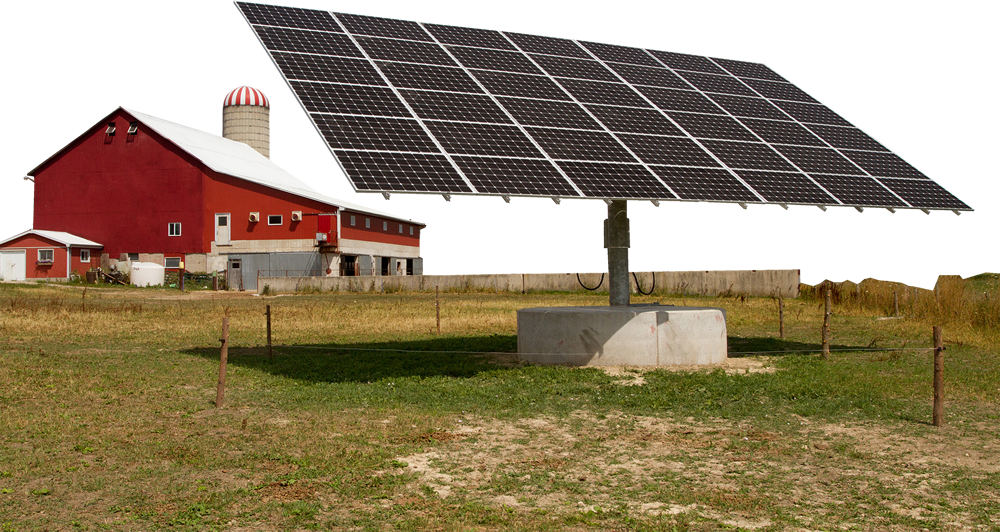
Keeping Electricity Costs Down for Consumers and Job Creators
Keeping electricity costs down for businesses helps create jobs and promote economic development. The government is continuing to provide electricity price relief for both people and businesses while investing in a clean and reliable energy system in Ontario.
Under the Comprehensive Electricity Plan (CEP), a portion of the costs of non-hydro renewable energy is being shifted from ratepayers to the government, lowering bills by about 14 to 17 per cent on average, for medium and larger sized industrial and commercial consumers
In addition, eligible farms and small businesses also benefit from the Ontario Electricity Rebate (OER), which continues to lower bills by providing a direct rebate on electricity costs for eligible consumers, including eligible residential customers, and ensuring that average residential bills rise at a predictable rate, well below the current rate of inflation.
The Northern Energy Advantage Program (NEAP) provides a rebate of two cents per kilowatt-hour for eligible mining, forestry and steel operations in Northern Ontario. The program was expanded to allow more businesses to qualify for funding, and the $20 million funding cap per participant, which existed under the former Northern Industrial Electricity Rate Program, was removed. The expanded NEAP helps eligible large industrial operators better manage electricity costs and create and sustain good jobs in Northern Ontario to maintain global competitiveness.

Helping Ontario Businesses Succeed
Helping Small Businesses Grow
As part of the plan to create the conditions for future growth, the government is helping small businesses compete and thrive by cutting taxes to lower their costs.
This is why Ontario provides over $3 billion in annual support to small businesses by offering a preferential small business Corporate Income Tax (CIT) rate of 3.2 per cent.
In the 2022 Ontario Economic Outlook and Fiscal Review, the government proposed to lower costs for more small businesses by expanding access to the small business CIT rate. The government plans to extend the range over which the benefit from the small business CIT rate is phased out and is proposing amendments to the Ontario Taxation Act, 2007 to implement the proposed change. The phase-out range would be extended from between $10 million and $15 million of taxable capital to between $10 million and $50 million of taxable capital. This change would mirror the corresponding federal measure and apply to taxation years that begin on or after April 7, 2022.
By expanding the phase-out range, the government would provide about 5,500 of Ontario’s small businesses with additional Ontario income tax relief of $265 million from 2022–23 to 2025–26.
An eligible corporation could receive over $36,000 in Ontario income tax relief each year. The examples in the chart below show the annual Ontario income tax savings to a corporation at $12 million, $15 million and $30 million of taxable capital.

Supporting Entrepreneurship in Ontario
Expanding Support for Young Entrepreneurs
Previous investments in Futurpreneur Canada have helped 221 Ontario businesses from April to December 2022 and have resulted in the creation of 1,105 jobs. To help entrepreneurs achieve their business goals, the government is providing an additional $2 million in 2023–24 to Futurpreneur Canada. The non-profit organization helps businesses led by people aged 18 to 39 by offering mentorship programs and loan capital worth up to $20,000. The government’s investment will also help address some of the unique economic barriers facing youth and women, as well as racialized and Indigenous entrepreneurs, to transform their entrepreneurial passions into thriving businesses.
Supporting Racialized and Indigenous Communities and Businesses
To help address systemic racism, Ontario is investing an additional $15 million over three years for the Racialized and Indigenous Supports for Entrepreneurs (RAISE) Grant Program that includes support for Indigenous, Black and other racialized people, as well as an additional $3 million in the Black Youth Action Plan. Together, this funding will provide Indigenous, Black and other racialized youth and entrepreneurs with support to help overcome barriers and participate in the economy.
Promoting Regional Innovation Centre Hubs
Regional Innovation Centre hubs play an important role in supporting entrepreneurship by collaborating with other Regional Innovation Centres and innovation organizations to ensure entrepreneurs have access to the tools they need to start and fuel their businesses. The Ottawa region continues to see growth and opportunity for innovators and entrepreneurs. For this reason, the government is providing an additional $1 million per year for three years to Invest Ottawa, starting in 2023–24, to expand into a Regional Innovation Centre hub for Eastern Ontario.
Building the Future of the Life Sciences Sector

Just as Ontario is developing a competitive advantage in electric vehicles and batteries, the province has a strong foundation to continue growing the life sciences sector. Over the past two and half years, Ontario has attracted nearly $3 billion in investments by global biomanufacturers. In November 2022, the government launched the Life Sciences Innovation Fund, a $15 million early‑stage fund to help life sciences entrepreneurs and innovators bring their ideas and prototypes from the lab to the marketplace. The fund is being delivered by the Ontario Centre of Innovation, and eligible companies will receive up to $500,000 to scale their made-in-Ontario health solutions.
The government is also creating an industry‑led Life Science Council to provide proactive advice on the complex challenges facing the sector, along with opportunities for increasing competitiveness and advancing made-in-Ontario solutions.
These two initiatives are instrumental to delivering Taking Life Sciences to the Next Level, the province’s strategy to grow Ontario’s life sciences sector and secure new investments in next-generation health technologies, medicines and vaccine manufacturing.
Supporting Ontario’s Emerging Marine Transportation Industry
Marine is a key component of Ontario’s multi-modal transportation system. The government is engaging on the development of Ontario’s first Marine Transportation Strategy. This initiative creates new opportunities and partnerships in the sector while supporting greater integration of the movement of people and of goods.
Driving Business and Job Growth by Investing in Critical Technologies
The adoption and commercialization of critical technologies are changing how businesses deliver products and services. The government is investing $107 million in new critical technology initiatives to provide access to and drive commercialization of technologies that will propel the next generation of innovation, fuel job growth, and ensure businesses remain competitive. In December 2022, the government launched a Request for Information (RFI) for initiatives focused on six critical technologies: 5G/Next Generation Networks, artificial intelligence (AI), quantum, robotics, blockchain and cybersecurity. The submissions that were received will inform the design of the Call for Proposals to be launched this spring to ensure the funding will be used to strengthen Ontario’s capacity and leadership in the development and adoption of these six critical technologies.
Supporting Business Through Government Procurement
Ontario is home to top talent driving world-class innovative solutions. For decades, Ontario businesses looking to work with the government have been frustrated by red tape, burdensome processes and a lack of transparency. This rewards those who know how to navigate the system rather than those who make the best products and value. Ontario is changing this by centralizing procurement, enhancing the rules and making significant investments in government adoption of Ontario-made solutions.
Procurement must be a key lever to driving Ontario’s economic development, innovation and supply chain stability. Entrepreneurs and local businesses looking to scale up will have more opportunity to participate in government procurement, increasing demand for made-in-Ontario products, creating well‑paying jobs in communities across the province, and leading to lower prices for Ontario consumers.
Modernizing Capital Markets and Financial Services
The government is enhancing consumer protection. This includes proposed amendments to the Insurance Act to support the Financial Services Regulatory Authority of Ontario (FSRA) in ending the use of deferred sales charges in the sale of segregated funds.
The government is also working to ensure consumers and investors receive appropriate advice when they obtain a mortgage. On April 1, 2023, new licensing classes for mortgage brokers and agents will be introduced in Ontario with enhanced education and experience requirements that focus on mortgage products funded by private lenders.
The Ontario Securities Commission (OSC) introduced several measures to improve access to capital for companies and access to markets for investors, including new prospectus exemptions, streamlined regulatory reporting requirements, and expanded eligibility for sophisticated investors. Ontario will continue to work closely with the OSC to protect investors, foster more competitive capital markets, and continue modernization efforts, including enhancing corporate diversity.
Enhancing Risk Management in the Financial Sector
The government is investing $3 million over three years to support effective risk management, through the Global Risk Institute. Founded in 2011 by the Ontario government, the Government of Canada and financial industry members, this non-profit organization brings together executives to develop actionable strategies addressing geopolitical, environmental and infrastructure-related risks. With this investment, Ontario will be better positioned to handle emerging risks and maintain its leadership in the financial industry.
Reviewing Ontario’s Tax System
As the government continues to deliver its plan to make Ontario an attractive place for businesses to invest and grow, it will be reviewing the province’s tax system.
The tax review will build on the government’s track record of supporting business, seniors and working families. It will prioritize competitiveness and long-term growth in the province, as well as the fairness and effectiveness of tax relief and supports.
The review will also focus on modernized administration tools that strengthen Ontario’s growth and prosperity and complement Ontario’s ongoing efforts to reduce red tape.
Modernizing Ontario’s Tax Administration System
Connecting with government should be easy and straightforward. This is why Ontario is making improvements to simplify tax administration by creating a more convenient, modern and digital platform. The government is also using its digital, agile and lean resources for a better customer service experience and to ensure tax and benefit services are delivered simply and quickly to save money for businesses and the people of Ontario. Continued investments in information technology (IT) infrastructure will bring more digital options to clients, and the collection of client feedback will guide the improvements to programs, services and the overall client experience.
Building Highways, Transit and Infrastructure Projects
Ontario’s population is growing, jobs are being created, businesses are investing, and the government is building infrastructure to support growth across the province. The workforce of today and tomorrow will build Ontario’s highways and roads, transit, hospitals, schools and long‑term care homes that will help alleviate gridlock, connect communities and lay the foundation to improve people’s access to jobs, public services, family and friends. To support the future of Ontario, the government plans to invest more than $184 billion over the next 10 years in public infrastructure.
This is the most ambitious capital plan in Ontario’s history.
Building Faster
The government is improving its practices to build highways, transit, and community infrastructure projects better and faster.
Accelerating Construction
In response to changing market conditions, the government continues to improve its procurement and delivery practices to mitigate schedule delays for projects. For example, the government is:
- Using a variety of delivery models and innovative procurement strategies that make it easier to collaborate with builders on project requirements, design and pricing to help ensure that Ontario gets robust and competitive bids for its infrastructure projects;
- Separating the scope of large complex projects, such as the Ontario Line, into smaller contracts to generate market interest and lay the foundation for future works; and
- Continuing the use of modular builds and promoting design standardization, while also continuing to work with municipalities to enable faster approvals.
In addition, the government introduced legislation to accelerate infrastructure construction while putting measures in place to protect health and safety. The Building Transit Faster Act, 2020 enables Ontario to expedite progress on priority transit projects. The Supporting Broadband and Infrastructure Expansion Act, 2021 and the Getting Ontario Connected Act, 2022 are making it easier for internet service providers (ISPs) to deploy infrastructure to provide faster access to reliable, high‑speed internet.
Measures introduced through Ontario’s Housing Supply Action Plan and the COVID‑19 Economic Recovery Act, 2020 that aim to speed up construction are also helping to speed up approvals to get infrastructure like housing, schools, hospitals and long-term care homes built faster.
Using Technology to Improve Infrastructure Planning, Delivery and Operations
The government will continue to leverage insights from industry to successfully deliver Ontario’s ambitious capital plan. For instance, digital twins are virtual representations of physical assets, systems or networks that are regularly updated with real-world data and provide key insights to optimize designs, maintenance, and operations, as well as reduce costs for stakeholders. This insight could be used to improve infrastructure planning and enable data-driven decision-making in the province.
As the government continues to make use of leading technology to build hospitals, highways, transit and other key infrastructure, digital twins can play a critical role in ensuring that these projects are delivered more effectively and efficiently.

The government is also enabling new ways to tackle key priorities such as safety, highway maintenance and gridlock through better use of available traffic and transportation-related information.
Through this initiative, Ontario will strengthen the use of transportation-related data and information services, improve program operations, and continue to find ways to leverage data to inform decision-making.
Training Workers to Build Ontario
Ontario is facing a historic labour shortage in the construction sector with over 28,800 vacancies in the third quarter of 2022, more than double the number in the same period in 2019. This is why Ontario is investing in skills training, including through the province’s Skilled Trades Strategy, the Skills Development Fund and Better Jobs Ontario. Ontario is leading the country by being the first in Canada to remove significant barriers for internationally trained workers and ensuring that out-of-province skilled workers can register in their regulated profession or trade within 30 business days. These investments will help get shovels in the ground faster to build highways, transit, hospitals, housing and other essential infrastructure projects across the province.
Fighting Gridlock
Gridlock on highways and roads costs the economy more than $11 billion2 a year in productivity, including time lost by commuters and drivers, higher costs of doing business and reduced access to jobs and housing, and keeps people from getting home to their families faster.
The Ontario government is continuing to execute its plan to deliver effective and resilient infrastructure that is built not just for today but for future generations.
Building Highway 413
The Greater Golden Horseshoe is one of the fastest-growing regions in North America. By 2051, population and employment figures in the Greater Golden Horseshoe are forecast to grow from 10 million to 14.9 million people, and from 4.9 million to 7 million jobs, respectively.
Ontario is moving ahead with its plan to build Highway 413, a new 400-series highway and transportation corridor across Halton, Peel and York regions that will bring relief to the most congested corridor in North America. Preliminary design, environmental assessment work and consultations are underway for the new route.
The proposed 52-kilometre (km) route will extend from Highway 400, between King Road and Kirby Road, to the 401/407 interchange near Mississauga, Milton and Halton Hills, with connections to Highways 400, 401 and the 407. The project also includes a four-km extension to Highway 410 and a three-km extension to Highway 427 for a total of 59 km on the corridor.
During construction, Highway 413 is expected to support up to 3,500 jobs each year and generate up to $350 million in annual real GDP.
Once completed, Highway 413 will help goods travel faster to, and through, the Greater Golden Horseshoe and save drivers up to 30 minutes each way on their commute.
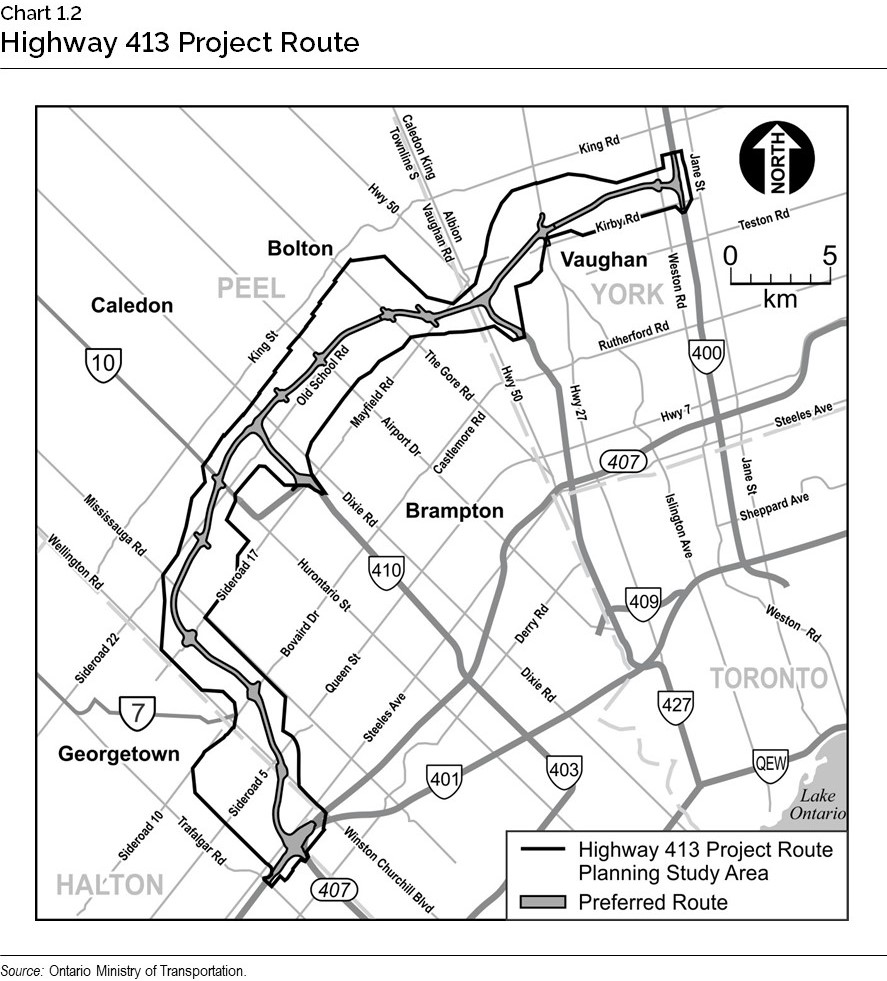
Building the Bradford Bypass
The County of Simcoe is expected to experience rapid population growth over the next 10 years, and York Region is expected to grow to approximately 1.8 million residents by 2041. To support this growth, the government is taking steps towards building the Bradford Bypass, a new four-lane freeway connecting Highway 400 in the County of Simcoe and Highway 404 in York Region. Motorists and commercial truck drivers are expected to experience significant savings of up to approximately 35 minutes in travel time when using the Bradford Bypass compared to using existing routes along local roads.
The Ontario government marked another milestone to relieve gridlock, create jobs and connect communities in the Greater Golden Horseshoe by starting construction on a bridge crossing over the future Bradford Bypass. In April 2022, the government awarded the contract to design and construct the new bridge, which will allow County of Simcoe Road 4 (Yonge Street) between 8th Line and 9th Line to cross over the future Bradford Bypass. The project will also include widening County Road 4 from two to four lanes.
Once complete, the Bradford Bypass will get goods to market faster and strengthen supply chains and is expected to support an estimated 2,640 jobs per year, on average, during construction as well as generate an estimated $274 million in annual GDP.
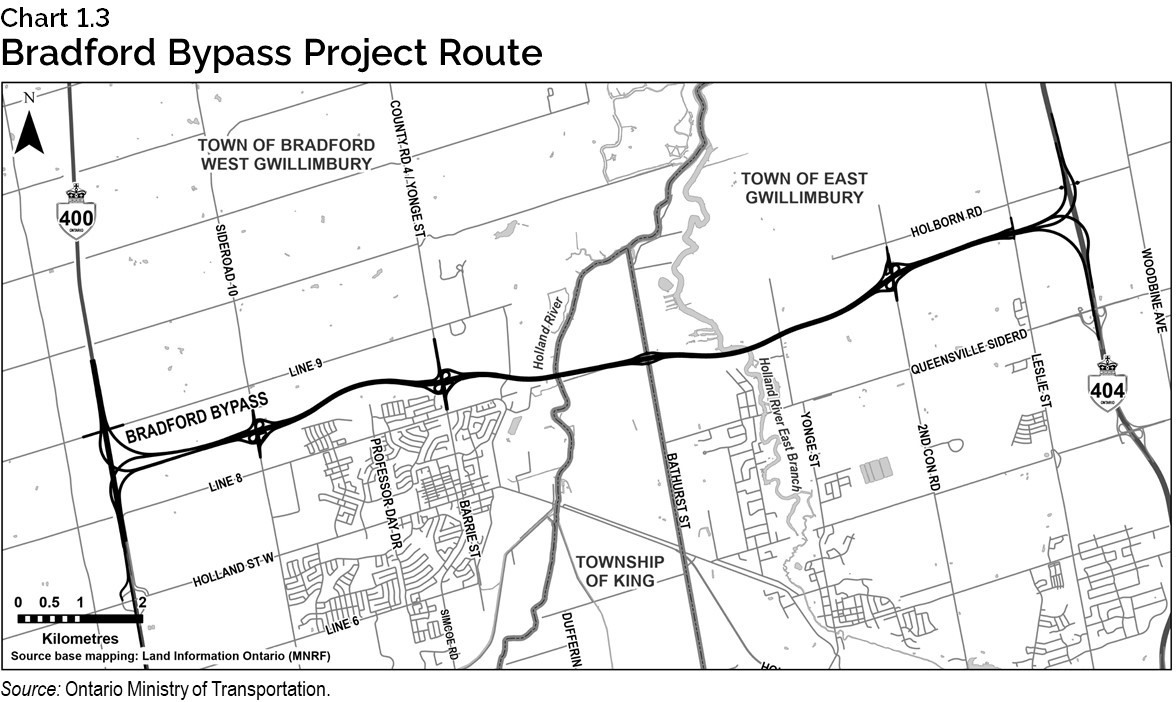
Expanding Highway 401 in Eastern Ontario
The Highway 401 corridor in Eastern Ontario is an important economic link between Ontario, Eastern Canada and the United States. It carries about 10,000 trucks with commodities valued at up to $380 million per day. The government is continuing work to widen Highway 401 from Brock Road in Pickering through Eastern Ontario, helping tens of thousands of drivers per day get to work and home faster and get goods moving quicker.
Twinning the Queen Elizabeth Way Garden City Skyway
Ontario is moving forward with the Queen Elizabeth Way (QEW) Garden City Skyway Bridge Twinning project, which includes construction of a new twin bridge on the QEW over the Welland Canal connecting the City of St. Catharines to the Town of Niagara-on-the-Lake. This section of the highway supports the province’s supply chain by linking the international border crossings at Niagara Falls and Fort Erie with the Greater Golden Horseshoe.
Building the New Highway 7
The next phase of construction for the new Highway 7 between Kitchener and Guelph will provide relief to the gridlocked Highway 401 and connect the fast-growing urban centres of Kitchener, Waterloo and Guelph. Design of the Frederick Street bridge replacement is well underway with utility work targeted to begin in 2023.

Building Roads, Highways and Bridges Across Ontario
The government is investing $27.9 billion over the next 10 years to connect communities, fight gridlock and keep goods and people moving across the province. The Ontario Highways Program includes more than 600 expansion and rehabilitation projects that are either underway or planned over the next four years. In 2023–24 alone, Ontario is investing $3.2 billion towards projects that will expand and repair provincial highways and bridges.
The Ontario Highways Program also includes widening existing corridors to increase capacity and enhance road safety for travellers by separating opposing lanes of traffic and providing additional passing opportunities, including:
- Completing the widening of Highway 17 from two to four lanes for 22.5 km between Arnprior and Renfrew;
- Widening Highway 3 from two to four lanes for 15.6 km between Essex and Leamington; and
- Widening Highway 11/17 from two to four lanes between Thunder Bay and Nipigon for 14.4 km starting east of Highway 587.
Table 1.1
Recently Completed Highway Projects
Northern
- Highway 101 east of Foleyet: Bridge replacement and resurfacing work west of Highway 144.
- Highway 69 in French River: Highway widening north of Highway 522.
- Highway 11/17 and Highway 61 in Thunder Bay: Resurfacing work of the Thunder Bay Expressway.
Eastern
- Amherst Island: Amherst Island Ferry Service dock replacements.
- Highway 401 in Grafton: Facility improvements at a maintenance patrol garage.
- Highway 417 in Ottawa: Bridge rehabilitation and replacement at Innes Road and Ramsayville Road.
Southwestern
- Highway 401 in Ayr: Construction of a new patrol yard at Regional Road 97.
- Highway 403 in Brant: Bridge rehabilitation and resurfacing work from West Quarter Townline Road to Bishopsgate Road.
- Highway 402 in Sarnia: Resurfacing work from Front Street to Lambton County Road 26 (Mandaumin Road).
Central
- Highway 410 in Brampton: Bridge rehabilitation and interchange improvements from Courtneypark Drive to Queen Street.
- Highway 403 in Hamilton: Resurfacing from Jerseyville Road to Wilson Street.
- Highway 400 in York: Highway widening from Major Mackenzie Drive to King Road.
Building Transit
By 2042, Ontario’s population is expected to reach nearly 20 million. Rapid growth in urban centres, along with other factors such as shifting work-life patterns and technological advancement, require upgrades to the existing transit system.
The Ontario government is investing $70.5 billion over the next 10 years for transit. Building Ontario through critical public transit projects is vital to supporting the province’s economy, alleviating gridlock, connecting more people to jobs and housing, and creating thousands of good, local jobs.
Building GO Transit

Ontario is continuing to transform the GO Transit rail network into a modern, reliable and fully integrated rapid transit network. Investments to expand GO Transit service will generate 8,300 annual jobs in the first 12 years of construction and delivery. This will also help reduce commute times and emissions. These investments will improve access and convenience across the Greater Golden Horseshoe and into Southwestern Ontario by steadily increasing service with faster trains, more stations and better connections. Recent milestones include:
- Kitchener GO Rail Extension: Following its contract award in May 2022, Metrolinx has begun work on Guelph Central GO Station to construct a second platform, a new storage track for maintenance vehicles and a passing track in the community of Breslau to allow trains moving in opposite directions to pass each other.
- Confederation GO Station: In October 2022, construction of the new station commenced. This new station will support a more integrated transit network for Hamilton, providing better connections to existing local transit and GO bus services, while facilitating future increased GO rail service opportunities to Toronto and Niagara Falls.
- Weston GO Station: In August 2022, construction for an additional platform was completed. The new platform serves an additional fourth track that supports GO Expansion’s plans for more frequent, reliable service on the Kitchener Line.
- Maple GO Station: Construction crews are continuing work to prepare for the future addition of a second track from Rutherford Road to McNaughton Road that will support high-frequency two-way service in the future.
- The Davenport Diamond: Work to enable frequent two-way GO service is continuing on one of the busiest flat train intersections in North America. Ontario is building a raised guideway to elevate the Barrie GO Line above CP freight train tracks. The concrete pour for the new guideway to carry GO trains above CP freight trains has been completed.
- Bowmanville GO Rail Extension: The procurement process is underway to construct the rail infrastructure required to extend GO rail service east of Oshawa into Bowmanville.
- Bramalea GO Station: The new bus loop is now open for GO Transit and Brampton Transit users. These improvements bring two bus services to one location, making it easier for customers to connect to their GO Train.
- Niagara GO Rail Extension: The government continues to work with rail partners to find ways to deliver increased service between Union Station and the Niagara Region.
Building Light Rail Transit (LRT)
The government continues to make progress on delivering rapid transit projects to make life easier for people by reducing travel times and creating more transit options.
- Hazel McCallion Line: The majority of construction is now complete for the Line’s operations, maintenance and storage facility. A new underpass has also been installed at Hurontario Street and the QEW to support installation of the rail tracks. The Hazel McCallion Line will bring an environmentally friendly and reliable transportation system to Mississauga and Brampton.
- Finch West LRT: This LRT will bring fast, reliable transit from Humber College to Finch West Station. Work on both stations has reached structural completion, meaning all steel and concrete work is now in place.
Building Transit-Oriented Communities
The Transit-Oriented Communities program is part of the government’s plan to build vibrant, complete, mixed-use communities at or around transit stations. Transit-Oriented Communities will help increase transit ridership, create sustainable communities, and build more homes, including more affordable housing, around GO Transit, light rail transit (LRT) and subways. While the province works to help build 1.5 million homes over the next decade, work is already underway to deliver on the Transit-Oriented Communities at eight future stations along the new Ontario Line and Yonge North Subway Extension, creating over 73,000 new jobs and approximately 48,000 new residential units.
The government is engaging with municipalities and building partners to explore new funding avenues to deliver cost-efficient transit solutions for commuters. For example, the value created through the Transit-Oriented Communities at the future Bridge and the High Tech stations will help build a new station at Royal Orchard along the Yonge North Subway Extension.
The government is preparing for the selection of building partners for Transit-Oriented Communities sites at future stations along the new subway lines, such as Corktown, Queen-Spadina, King‑Bathurst and Exhibition stations. Building partners have been found for several future stations, with the government signing an agreement in April 2022 for a Transit-Oriented Community at the future East Harbour Transit Hub. The planned 38‑acre East Harbour site will include the creation of a major employment centre, new residential and commercial space, community amenities and parkland, as well as affordable housing.
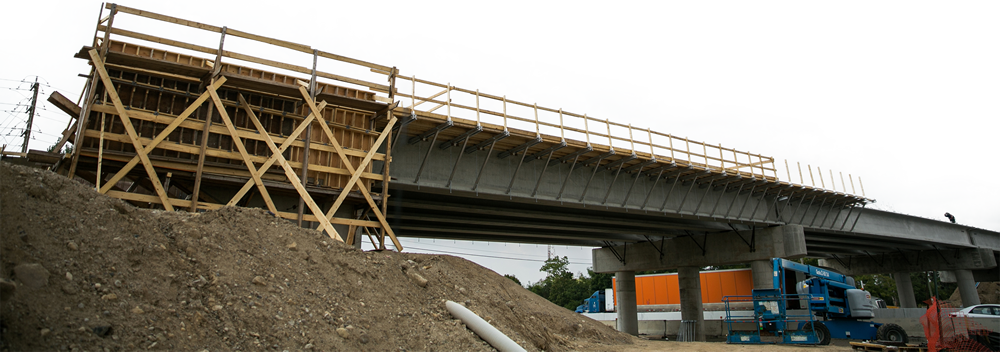
Building Subways
Ontario’s bold plan for the largest subway expansion in Canadian history includes the Ontario Line, the Scarborough Subway Extension, the Yonge North Subway Extension and the Eglinton Crosstown West Extension. With shovels now in the ground on three out of four of Ontario’s priority subway projects, the government is closer to providing better travel options, alleviating gridlock on the roads and creating thousands of good, local jobs.
There is a strong case for providing Ontario with a world-class and sustainable transport system that will not only support economic development but keep up with projected growth. Once complete, the four subways will see estimated daily ridership of:
- 388,000 trips for the Ontario Line;
- 92,100 trips for the Yonge North Subway Extension;
- 52,000 trips for the Scarborough Subway Extension; and
- 37,000 trips for the Eglinton Crosstown West Extension.
The combined subway projects will support more than 16,000 jobs annually during construction over the next decade. Shovels are in the ground, with recent milestones including:
- Ontario Line: In addition to awarding the two major works packages, the government also released two Requests for Qualifications (RFQs) for the northern segment of the Ontario Line, which includes work for the Pape Tunnel and underground stations and the elevated guideway and stations.
- Scarborough Subway Extension: In January 2023, tunnelling began for the Scarborough Subway Extension. The tunnel boring machine for the subway will travel about 10 to 15 metres a day, making its way south towards Eglinton Avenue East and Midland Avenue, where it will be extracted. In November 2022, the government also selected a development partner for the Stations, Rail and Systems Contract. This contract includes design and construction of three new underground stations and bus terminals at each station.
- Yonge North Subway Extension: Upgrades at Finch Station including early works, which will include improvements made to the electrical system that powers the rails, is underway.
- Eglinton Crosstown West Extension: Tunnelling on the project has also commenced. As of March 1, 2023, the two boring machines have tunnelled more than a combined 5.6 kilometres.


Building Safe and Reliable Transportation for Northern Communities
Northern communities need transportation options that connect them to the rest of the province and provide access to goods and services in other regions. Reinstating the Northlander and improving road safety demonstrates real progress to build a better transportation network for the North.
Bringing Back the Northlander
Ontario is delivering on its promise to restore passenger rail service in Northern Ontario. The reinstated Northlander train will support industries, resource sectors, and provide a safe and reliable transportation option for Northern communities, especially in the winter months.
The government is investing $139.5 million for three new trainsets that will bring back passenger rail service between Timmins and Toronto, unlocking the economic potential of Northern industries, resources and minerals.
This purchase demonstrates real progress, as the government continues to take concrete steps to build a better transportation network for the North.
The new rail cars will be built by Siemens Mobility Limited and will include built-in wheelchair lifts, mobility aid storage spaces and fully accessible washrooms. The trainset interiors will also feature spacious seating and modern amenities, including Wi-Fi connectivity. Once reinstated, the Northlander train will ensure access to essential services like health care and education, while supporting economic prosperity and tourism in the region and strengthening the connection between the North and the South.

Investing in Winter Roads
Ontario’s winter roads network provides seasonal connections to all-season roads for remote First Nation communities in the Far North. The winter roads network makes it possible for remote communities to deliver essential goods and services, support special projects, including bridge improvements, maintenance of crossings and other repairs, and enable inter-community connections.
This is why the government is improving the reliability, safety, and environmental impact of the winter roads network by investing an additional $5 million in annual funding for Winter Roads Program enhancements.
Improving Road Safety in the North
The Ontario government has improved road safety in Northern Ontario by creating a new standard for clearing snow. In November 2022, Ontario established the new “ON Trans-Canada” standard, which requires contractors to clear Highways 11 and 17 within 12 hours of the end of a winter storm, four hours faster than previously prescribed.
Building Community Infrastructure and High-Speed Internet
Communities across Ontario are growing rapidly and will need investments in hospitals, long-term care facilities, schools, child care spaces, recreational centres, and high-speed internet to help communities remain strong, healthy and safe for years to come.
Redeveloping Ontario Place
The Ontario government is delivering on its promise to bring Ontario Place back to life, making it a remarkable world-class destination for everyone to enjoy. Ontario Place is being redeveloped into a year-round destination that will include family-friendly entertainment, public and event spaces, waterfront access, health and wellness services, and an indoor-outdoor live music and performance venue. This once-in-a-generation redevelopment project is expected to create approximately 5,000 jobs and attract four to six million visitors every year.
The provincial government is making progress to revitalize Ontario Place by:
- Modernizing the site and preparing the land for development by upgrading site services through the release of the Request for Proposal (RFP) in December 2022;
- Working with independent heritage experts and experienced construction managers to make essential repairs to protect the iconic Cinesphere, Pod Complex and bridges; and
- Continuing to advance the Environmental Assessment and public realm design process for the government-led portion of the site, which includes consultation and engagement with Indigenous communities, stakeholders, and the public.
Once complete, Ontario Place will provide the public with access to a beach, enhanced waterfront, green space and parkland, as well as a variety of experiences and recreational activities including waterfront trails.
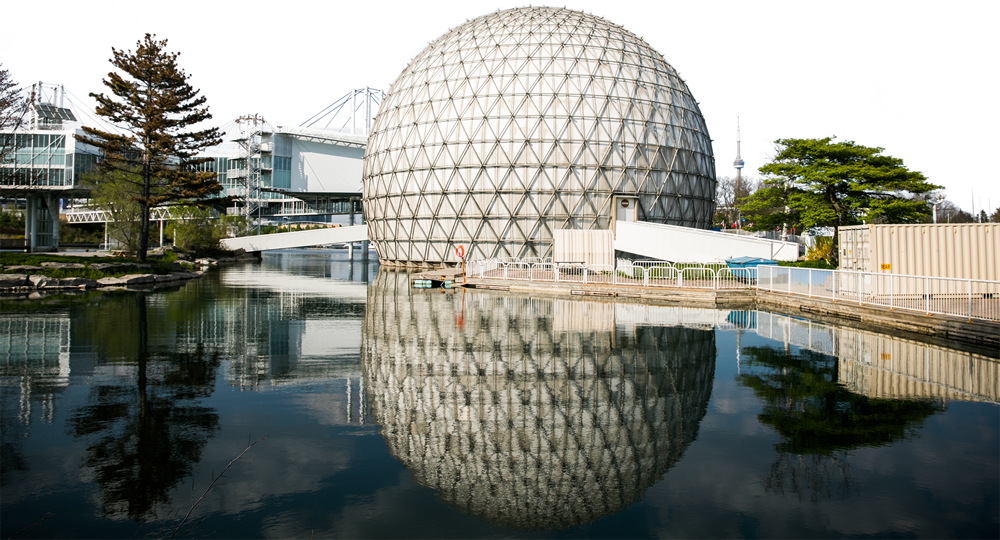
Building Hospitals
As part of its plan to build a more connected and convenient health care system, the government is implementing the most ambitious plan for hospital expansion in Ontario’s history, investing over $48 billion over the next 10 years in hospital infrastructure, including over $32 billion in hospital capital grants. This includes supporting more than 50 hospital projects that would add 3,000 new beds over 10 years to increase access to reliable, quality care. Recent milestones include:
- Grand River Hospital and St. Mary’s General Hospital Joint Redevelopment Project: The 2022 Budget announced the planning of the Grand River Hospital and St. Mary’s General Hospital Joint Redevelopment Project to construct a new, joint acute care facility and expand existing facilities in the Kitchener‐Waterloo region.
- Toronto East Health Network – Michael Garron Hospital Phase 1 New Patient Care Tower: In early 2023, Ontario completed construction of the Michael Garron Hospital’s new patient care tower, which houses 215 beds in a new, modern facility. Other renovations are underway to support the hospital’s clinical programs.
- Centre for Addiction and Mental Health – Phase 1D Redevelopment Project: In December 2022, Ontario released the RFP for the Forensic Building component to the Phase 1D Redevelopment Project. These critical expansion and redevelopment plans provide inpatient capacity of up to 214 beds for the forensic mental health program, including 33 new inpatient beds.
- Queensway Carleton Hospital – Mental Health Redevelopment Project: In December 2022, construction of the new addition was completed. This project adds two new acute mental health beds and expands space for mental health and addictions programs and services. The remaining renovations are scheduled to be complete by November 2023.
- Brock Community Health Centre – New Build Project: In April 2022, Ontario supported the construction of the project, which is currently underway. The project will establish a new purpose-built facility in Cannington to consolidate community-based health services from six community locations. This project will improve operational efficiencies, expand community access to services and improve patient care. The project is targeted to be complete by December 2023.
- Dave Smith Youth Treatment Centre – Phase 2 Redevelopment Project: In April 2022, Ontario awarded the construction contract for the project. This project will improve access to mental health and addictions services by providing six new beds and will house one 15-bed wing for women and one 15-bed wing for men, with spaces for home living, treatment and after-care services. The project is scheduled to be complete in November 2023.
The government is supporting major hospital projects including:
- Windsor Regional Hospital – New Windsor-Essex Acute Care Hospital: Support for a new hospital to consolidate acute care services, while retaining the existing Ouellette site for urgent care and ambulatory services.
- Oak Valley Health – Uxbridge Hospital: Continued support for the construction of a new, modern hospital facility on the existing Uxbridge site at the Oak Valley Health – Uxbridge Hospital to replace the current aged building and enable the expansion of specialized outpatient clinics as well as the creation of a community health hub with long‐term care services.
- Scarborough Health Network – Birchmount Redevelopment: Expansion of the Scarborough Health Network – Birchmount site with a new inpatient tower and an expanded emergency department to reduce wait times, improve patient flow and update aging infrastructure.
- William Osler Health System – Peel Memorial Emergency Department: Transformation of the existing site and urgent care centre into a new 24/7 inpatient care hospital at Peel Memorial, in partnership with William Osler Health System. This will enable future development of an emergency department and meet the growth needs of one of Ontario’s fastest growing communities.
Building Long-Term Care Beds
Ontario continues to make progress on its plan to build modern, safe and comfortable long-term care homes for seniors and residents. Through planned investments that total a historic $6.4 billion since 2019, Ontario is on track to build more than 31,000 new and over 28,000 upgraded beds across the province by 2028.
Since the 2022 Ontario Economic Outlook and Fiscal Review, the following long-term care homes have been completed and opened to new residents:
- Meaford Long-Term Care opened in December 2022 with 51 new long-term care beds and 77 upgraded long-term care beds in Meaford;
- Southbridge Owen Sound opened in December 2022 with 91 new long-term care beds and 69 upgraded long-term care beds in Owen Sound; and
- Southbridge Kemptville opened in October 2022 with 94 new long-term care beds and 66 upgraded long-term care beds in North Grenville.
Construction continues to progress on three long‐term care homes under the Accelerated Build Pilot Program in Mississauga and Toronto. The homes are expected to open for residents in 2023. The first home under the Accelerated Build Pilot Program, Lakeridge Gardens, located next to Lakeridge Health’s Ajax Pickering Hospital, opened 320 beds to residents in March 2022.
Of the 364 projects announced to date, 138 projects are proposed to be part of “campus of care” models that integrate the long-term care home into the broader health care system and ensure residents have access to the care they need. In November 2022, the government announced an increase to the construction funding subsidy to support the cost of developing or redeveloping a long-term care home. This additional funding will help fast-track projects to construction before August 31, 2023.
Building More Schools
Maintaining school infrastructure is critical to students and helps ensure that they learn in an environment that is modern, safe and accessible. This is why the government is investing about $15 billion in capital grants over 10 years to support student achievement by expanding and renewing schools and child care spaces.
Table 1.2
Examples of School Projects Under Construction and Recently Opened
Northern
- A new English public elementary and secondary school in Atikokan will serve 354 students and include 49 licensed child care spaces.
- The retrofit of Chelmsford Valley District Composite School into an elementary and secondary school in Chelmsford will serve 540 students.
- A new joint public school between the French public and Catholic school boards in Iroquois Falls will serve 240 secondary students.
- A new English public elementary school in North Bay will serve 308 students and include 73 licensed child care spaces.
- The Churchill Public School addition in Sudbury will add 49 licensed child care spaces to an existing school serving 433 students.
Eastern
- A new joint public school between the French public and Catholic school boards in Kingston will serve 600 secondary students and include 49 licensed child care spaces.
- A new English Catholic elementary school in Nepean will serve 507 students and include 39 licensed child care spaces.
- A new English public elementary school in Ottawa will serve 628 students and include 39 licensed child care spaces.
- A new French public elementary school in Ottawa will serve 475 students and include 49 licensed child care spaces.
Southwestern
- A new English public secondary school in Amherstburg will serve 819 students.
- A new English public elementary school in Kitchener will serve 591 students and include 88 licensed child care spaces.
- A new English public elementary school in London will serve 556 students and include 88 licensed child care spaces.
- A new English Catholic secondary school in Windsor will serve 850 students.
Central
- A new English Catholic elementary school in Alliston will serve 470 students and include 49 licensed child care spaces.
- A new English public elementary school in Bradford will serve 501 students and include 39 licensed child care spaces.
- A new English public elementary school in Milton will serve 908 students and include 88 licensed child care spaces.
- The École secondaire catholique Sainte-Trinité addition in Oakville will add 180 secondary spaces and now serve 728 students.
- The École élémentaire et secondaire publique Ronald-Marion addition in Pickering will create 49 child care spaces.
Source: Ontario Ministry of Education.
Building More Child Care Spaces
As part of the Canada-wide Early Learning and Child Care Agreement, Ontario is making progress on its commitment to create 86,000 new, high‐quality child care spaces by December 2026. This includes more than 33,000 licensed child care spaces created since 2019. Through this investment, families in small and large communities will benefit from high-quality child care that is affordable, accessible and inclusive.
Expanding High-Speed Internet Access
Access to high-speed internet is essential for the growth and prosperity of communities across Ontario. High-speed internet allows people to access critical health services, learn and work online, and connect with loved ones.
The Ontario government will ensure that high-speed internet access reaches every part of the province, whether it be rural farmland in Southern Ontario or a fly-in First Nation community in the Far North. The government is working closely with its agencies and partners to reach underserved areas using a full range of technologies and business models.
The government is investing nearly $4 billion to ensure every community across the province has access to high‐speed internet by the end of 2025. Multiple broadband programs and initiatives are being used to meet this goal, many of which are well underway, and are already providing access to internet service and better cellular connectivity, including:
- Completing in spring 2022, an innovative competitive bidding process that quickly and cost-effectively identified service providers for underserved areas in Ontario. Agreements are being completed with eight successful Internet Service Providers (ISPs) that represent a diverse selection of local, regional and national carriers, helping with market competition and consumer choice.
- Rolling out the Improving Connectivity for Ontario (ICON) program and developing co-funded projects with the Government of Canada through the federal Universal Broadband Fund. This funding will provide high-speed internet access to more homes and businesses in communities across Ontario.
- Investing more than $63 million in the Southwestern Integrated Fibre Technology (SWIFT) project to bring high‐speed internet access to 63,000 more homes, businesses and farms across Southwestern Ontario. To date, 65 of 97 SWIFT projects have been completed, bringing high‑speed internet access to over 44,000 homes and businesses.
- Investing $71 million in the Eastern Ontario Regional Network (EORN) to improve access to cellular service. This project is expected to generate as many as 3,000 jobs over 10 years and provide greater choice to residents and businesses.
- Improving connectivity in Northern Ontario, including $10.9 million to bring improved internet access to several towns and First Nation communities across Northern Ontario.
Investing in Canada Infrastructure Program
The Investing in Canada Infrastructure Program (ICIP) provides up to $30 billion in combined federal, provincial and partner funding over 10 years. Since June 2018, Ontario has committed to investing a total of $10.2 billion across five ICIP sub streams: the Public Transit Infrastructure Stream, the Green Infrastructure Stream, the Rural and Northern Communities Infrastructure Stream, the COVID‑19 Resilience Stream, and the Community and Culture Recreation Stream.
Table 1.3
Examples of Recently Approved and Completed ICIP Projects
Northern
- Construction and rehabilitation work to create a community hub in the Township of Moonbeam. Improvements include the installation of a pavilion, new skating rink boards, rehabilitation of the tennis court and resurfacing of paved nature trails with asphalt.
- Renewal of Camp Tillicum with upgrades to the campgrounds, a new accessible multi-purpose facility for youth-oriented recreational programming and education in North Bay.
- Replacement of water distribution and wastewater collection lines on Second Street and Broadway Avenue to ensure better water distribution and fire protection for residents in Rainy River.
Eastern
- Rehabilitation and expansion of the water treatment system in Alderville First Nation. Upgrades include installing a high‑capacity communal treatment plant with back-up power and an underground reservoir for water storage.
- Rehabilitation of nearly 1.25 kilometres of County Road 2 leading to Morrisburg, including the construction of a roundabout, centre medians, improving entrances to local businesses, building sidewalks and pedestrian crossovers in Cornwall.
- Replacement of ventilation and air conditioning at the John M. Parrott Centre to improve indoor air quality for residents within the home in the Town of Greater Napanee.
Southwestern
- Upgrades to Eastwood Park for new accessible pathway systems, a new multi-use court, playground equipment and a large shade structure in the Municipality of Central Elgin.
- Implementation and construction of a multi-use trail to connect residents from the Iron Horse Trail with the future Transit hub in Kitchener and Waterloo.
- Replacement of an 18.5 metre culvert on Tecumseh Road in the Walpole First Nation to improve drainage and road reliability.
Central
- The replacement of a single-lane bridge with a wider two-lane bridge to improve traffic circulation, safety and reliability for drivers in Durham.
- Creation of a children’s education gallery at the Lincoln Museum and Cultural Centre to increase access to education and physical activities in the Town of Lincoln.
- Renovating the Everton and Lescaut booster pump stations in Midland to improve access to clean and reliable drinking water for its residents.
- Revitalization of Humber Flats Mallard Marsh Park and Phillips Park to increase community safety by updating playground equipment, safety surfacing, walkways, park furniture and other upgrades to ensure the trail meets accessibility standards in Richmond Hill.
Source: Ontario Ministry of Infrastructure.
Doubling the Ontario Community Infrastructure Fund
The Ontario Community Infrastructure Fund (OCIF) provides investments in local infrastructure and asset management planning. The government doubled its annual investment to nearly $2 billion over five years, beginning in 2021–22, to help 425 small, rural and Northern communities to construct and repair community infrastructure such as roads, bridges, water and wastewater infrastructure. In 2023, the government will provide approximately $400 million through the OCIF to support job creation and drive economic growth with funding for roads, bridges, water and wastewater projects.
Table 1.4
Examples of Recently Approved and Completed OCIF Projects
Northern
- Rejuvenation of Main Street in North Bay, including reconstruction of all surface infrastructure and sidewalks.
- Upgrades to watermain lining and water distribution infrastructure in Timmins.
Eastern
- Rehabilitation of Second Line Road Bridge in South Glengarry, including replacing barrier walls, waterproofing, and paving of approach barriers.
- Reconstruction of Boundary Road in the Township of Leeds and the Thousand Islands to extend the life of the community’s road assets.
Southwestern
- Reconstruction of Laurel Street to add a sidewalk and a wider road platform for cycling that will improve connections to community amenities and various areas in Paris.
- Reconstruction of a portion of Plank Road in Sarnia, including the replacement of the existing watermain, ditches, and asphalt on city streets.
Central
- Upgrades to sidewalks, underground water and sewer pipes in Huntsville
- Replacement of the watermain along Brownsville, as well as the lining of existing watermains along Western, Elmwood and Castlewood Avenues in Schomberg, and reconstruction of the roadway along Brownsville Court in the Township of King.
Supporting Conservation
The government’s plan includes the conservation of Ontario’s natural areas to help protect species and their habitats, improve soil health, and support outdoor recreational enjoyment for future generations and mitigate the effects of climate change.
Protecting Ontario’s Natural Areas and Boreal Caribou
The government is expanding the Greenlands Conservation Partnership by investing an additional $14 million in 2023–24. The investment will allow conservation partners to raise matching private-sector contributions to secure new, privately owned natural areas, such as wetlands, grasslands and forests, and ensure they are protected and managed for the future.
Ontario is also protecting its boreal caribou population, which is classified as a threatened species provincially and nationally. Ontario entered into a five-year agreement with the Government of Canada in April 2022, which included commitments to conservation measures, such as monitoring, habitat protection and restoration, stewardship collaborations and updates to caribou conservation frameworks. The initiatives to protect Ontario’s boreal caribou will consider the economic prosperity of Ontario businesses and economic activities such as forestry, mineral exploration and development in Northern Ontario communities that depend on them.
Investing in Ontario’s Soil Strategy
Healthy soil is essential to strengthening Ontario’s agri-food supply chain stability and local food production. Together with over 20 partners from the province’s agriculture and food commodity organizations, academia and Conservation Authorities, Ontario has committed to developing and implementing Ontario’s Agricultural Soil Health and Conservation Strategy. This soil strategy is a long-term framework that sets the vision, goals and objectives for soil health and conservation in Ontario to 2030 with accompanying actions and methods to measure progress.
The government has committed $9.5 million over the next three years to improve soil data mapping and soil evaluation and monitoring, and to support key commitments under the strategy. Soil data and interpretive maps support on-farm decision-making, enabling farmers to innovate and use technology to improve their long-term viability so that they can remain competitive in the global market.
Creating New Provincial Green Spaces
Ontario is also building stronger and healthier communities by expanding recreational opportunities for families to enjoy. This is why the government is actively taking steps to open the first new, full‑service, operating provincial park in 40 years. The new park will offer four-season facilities and recreational activities including swimming, hiking, cross-country skiing, and add 250 new campsites to the Ontario Parks system. The location of the park and its facilities is in the process of being finalized.
To enhance protection of Southern Ontario’s green spaces, the government is exploring the creation of a new provincial protected area in the Township of Uxbridge.
Footnotes
[1] Buildforce Canada, “Forecast Summary Report for Ontario,” (2022), https://www.buildforce.ca/en/lmi/forecast-summary-reports?year=2022
[2] Benjamin Dachis, C.D. Howe Institute, “Cars, Congestion and Costs: A New Approach to Evaluating Government Infrastructure Investment,” (2013), https://www.cdhowe.org/public-policy-research/cars-congestion-and-costs-new-approach-evaluating-government-infrastructure-investment
Chart Descriptions
Chart 1.1: Annual Ontario Corporate Income Tax Savings from Extending the Proposed Small Business Limit Phase-Out
The chart shows three examples of the annual Ontario corporate income tax savings for a corporation.
In Example 1, the corporation’s taxable capital is $12 million. The corporation’s annual tax savings under the current phase-out of the small business limit is $24,900. The proposed phase-out of the small business limit would provide an additional annual Ontario corporate income tax savings of $14,525. The total annual Ontario corporate income tax savings to this corporation from the proposed small business limit phase-out would now be $39,425.
Examples 2 and 3 show the annual Ontario corporate income tax savings for corporations with $15 million and $30 million of taxable capital. In both cases, the corporations do not receive tax savings under the current small business limit phase-out. Under the proposed small business limit phase-out, the corporation with $15 million of taxable capital would receive a new tax savings of $36,312, and the corporation with taxable capital of $30 million would receive a new tax savings of $20,750.
Note: Each example assumes the corporation has at least $500,000 in taxable income and active business income.
Source: Ontario Ministry of Finance.
Chart 1.2: Highway 413 Project Route
This map illustrates the proposed route of Highway 413, a 52-kilometre highway and transportation corridor that will extend from Highway 400 (between Kirby Road and King-Vaughan Road) in the east to the Highway 401/407 Express Toll Route (ETR) interchange area in the west, connecting the regions of York, Peel and Halton.
Source: Ontario Ministry of Transportation.
Chart 1.3: Bradford Bypass Project Route
This map illustrates the proposed route of the Bradford Bypass, a 16.3-kilometre controlled access freeway connecting Highway 400 and Highway 404 in the County of Simcoe and Regional Municipality of York. The proposed highway would extend from Highway 400 between 8th Line and 9th Line in Bradford West Gwillimbury, cross a small portion of King Township, and connect to Highway 404 between Queensville Sideroad and Holborn Road in East Gwillimbury.
Source: Ontario Ministry of Transportation.
Chart 1.4: Widening Highway 401 from Mississauga to Milton
This map shows the widening project on the previous six-lane Highway 401 from the Credit River in Mississauga to Regional Road 25 in Milton, highlighting the following:
- A 12-lane core-collector system from the Credit River to Winston Churchill Boulevard;
- 10 lanes from Winston Churchill Boulevard to the Highway 407 ETR/Highway 401 interchange;
- A 12-lane core-collector system from Highway 407 ETR/Highway 401 interchange to east of James Snow Parkway;
- 10 lanes from James Snow Parkway to west of Regional Road 25; and
- Nine new widened bridges.
Chart 1.5: Building Transit in the Greater Golden Horseshoe
This map shows various transit lines in the Greater Golden Horseshoe highlighting the following:
Yonge-University Line
- Provides two-way subway service from Finch Station to Vaughan Metropolitan Centre Station connecting North York and Vaughan.
- Key stops from east to west include Sheppard Yonge, Eglinton, Bloor-Yonge, Queen, Union Station, St George, Spadina, Cedarvale/Eglinton West, Downsview Park and Finch West.
Bloor-Danforth Line
- Provides two-way subway service from Kennedy Station to Kipling Station connecting Scarborough to Etobicoke.
- Key stops from east to west include Main, Pape, Bloor-Yonge, St George, Spadina and Dundas West.
Sheppard Line
- Provides two-way subway service from Don Mills Station to Sheppard Yonge Station in North York with a key stop at Leslie Station.
Eglinton Line
- Provides two-way light rail service from Kennedy Station to Mount Dennis Station along Eglinton Avenue.
- Key stops from east to west include Science Centre, Eglinton, Cedarvale and Caledonia.
GO Lines
- The Barrie Line provides GO train service from Union Station in downtown Toronto to Allandale Waterfront Station in Barrie.
- The Kitchener Line provides GO train service from Union Station in downtown Toronto to Kitchener.
- The Lakeshore East Line provides GO train service from Union Station in downtown Toronto to Oshawa/Bowmanville.
- The Lakeshore West Line provides GO train service from Union Station in downtown Toronto to both Hamilton and Niagara Falls.
- The Milton Line provides GO train service from Union Station in downtown Toronto to Milton.
- The Richmond Hill Line provides GO train service from Union Station in downtown Toronto to Bloomington Station in Richmond Hill.
- The Stouffville Line provides GO train service from Union Station in downtown Toronto to Lincolnville Station in Stouffville.
Yonge North Subway Extension
- Will provide additional two-way subway service north of Finch Station with five new additional stations — Steeles, Clark, Royal Orchard, Bridge and High Tech.
- Potential station at Cummer.
Scarborough Subway Extension
- Will provide additional two-way subway service northeast of Kennedy Station with three new stations — Lawrence, Scarborough Centre and Sheppard.
Ontario Line
- Will provide additional two-way subway service connecting the Ontario Science Centre to Exhibition Place through downtown Toronto.
- The new line will feature 15 stops including Flemingdon Park, Thorncliffe Park, Cosburn, Pape, Gerrard, Leslieville, East Harbour, Corktown, Moss Park, Queen, Osgoode, Queen/Spadina and King/Bathurst.
Eglinton Crosstown West Extension
- Will provide additional light rail service west of the future Mount Dennis station with seven new proposed stops at Jane, Scarlett, Royal York, Islington, Kipling, Martin Grove and Renforth.
- Includes proposed connection to the Toronto Pearson International Airport.
Proposed Sheppard East Extension
- Would provide additional two-way subway service by expanding the existing Sheppard Line east of Don Mills Station to the new Sheppard Station in Scarborough.
Hazel McCallion Line
- Will provide new light rail service in Peel Region connecting Port Credit Station in Mississauga to Steeles Station in Brampton along Hurontario Street.
Finch West Light Rail Transit
- Will provide new light rail service connecting Finch West Station on the Yonge-University Line to Humber College.
Hamilton Light Rail Transit
- Will provide new light rail service connecting Eastgate Square to McMaster University through downtown Hamilton.
- The new line will feature 17 stops including Nash, Parkdale, Queenston, Kenilworth, Ottawa, Gage Park, Scott Park, Sherman, Wentworth, Wellington, Mary, James, Queen, Dundurn and Longwood.
Source: Ontario Ministry of Transportation.
